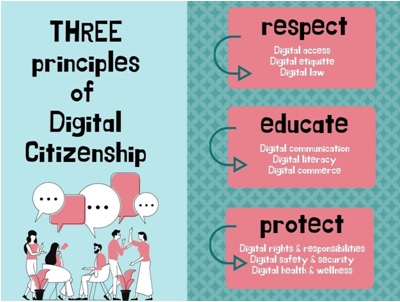"Those who use the internet regularly and effectively" are called Digital Citizen.
The term "digital citizenship" refers to the capacity to interact constructively, critically, and competently in the digital world. It also means utilising the abilities of clear communication and creation to engage in social behaviours that respect others' rights and dignity while using technology responsibly.
Digital Participation and Its Types:
People who are identify as "digital citizens" frequently engage in considerable IT use, including blogging, social networking, and online journalism. Although any child, teen, or adult who registers for an email account, uploads pictures online, utilises e-commerce to buy goods online marks the beginning of their digital citizenship journey, though the procedure of becoming a digital participant extends beyond simple internet usage.
A main framework of citizenship, according to Thomas Humphrey Marshall, a British sociologist noted for his research on social citizenship, consists of three distinct traditions: liberalism, republicanism, and inscriptive hierarchy. The digital citizen is necessary within this framework in order to advance fair economic possibilities and raise political engagement. In this sense, digitalization aids in lowering the entry barriers for citizenship within a society.
They also have a thorough awareness of digital literacy, which refers to using technology in an appropriate and responsible manner. Since digital citizenship assesses how well a person responds to being a member of a digital community, it frequently calls for engagement from all members of the community, both prominent and less prominent.
Digital literacy, manners, online safety, and understanding of the difference between private and public information are all important components of being a responsible digital citizen. There are two primary phases in the evolution of digital citizen participation.
Information dissemination, which has several subcategories of its own, constitutes the initial stage:
- Citizens who utilise read-only websites to control data from reliable sources in order to generate opinions or facts are significantly responsible for the Static Information Dissemination. Many of these trustworthy information-finding websites are offered by the government.
- Dynamic Information Dissemination involves both individuals and public officials and is more interactive. Through two-way communication platforms, both questions and answers can be conveyed, and citizens have the chance to participate in question-and-answer discussions.
Citizen discussion, the second stage of digital citizen engagement, assesses the level of participation and the role that citizen’s play in efforts to spark some kind of policy change.
- Static citizen participants can contribute by taking part in online surveys and submitting complaints and suggestions, mostly to the government, which has the power to alter policy decisions.
- Dynamic citizen participants can discuss their ideas and suggestions with others in town hall meetings or on various media platforms.
Principles of Digital Citizenship:
The term "digital citizenship" refers to a user's ethical and acceptable use of technology. Mike Ribble created the three guiding principles of respect, educate, and protect to instruct people on how to use technology responsibly and evolve into digital citizens. Three of the nine components of digital citizenship are present in each principle.
- Respect is demonstrated by following the rules of decorum, access, and the law.
- Educate is to learn about proper usage of the digital world, knowledge, interaction, and commerce are used.
- Protect is to be safe in both the digital and analogue worlds, the components of rights and obligations, privacy, and health and wellbeing are utilised.

Educating about Digital citizenship:
Digital access is the first component that is predominant in today's school curriculum, as per Mike Ribble. Additionally important digital components include etiquette, literacy, commerce, and communication. He also stressed the need for educators to recognise the value of technology for all children, not just those who have access to it, in order to bridge the present digital gap.
The objectives of digital citizenship education overlap with prevailing educational trends. Together, these elements support the growth of a sound and successful curriculum for digital communication and information technology.
Digital footprint: Recognition that sharing and obtaining online information can be monitored, marketed to, and followed by, users. The use of the internet and people's digital footprints can have both positive and bad effects; however managing one's digital footprint can be a component of digital literacy. Digital footprints can be created by other internet users as well as by those who actively participate in the creation and sharing of content on various media websites.
Digital literacy: Digital Literacy as "the ability to understand and use information in multiple formats from a wide range of sources when it is presented via computers." The ability to create, find, and consume content online as well as share that content with others constitutes a component of digital literacy.
Information literacy: It is the ability to identify information that is valuable, locate it, assess it, and use it. This ability is defined by the American Library Association. This can be achieved by producing new material, conducting research, participating in academic discussions, or even by typing terms into a web browser.
Copyright, respect for intellectual property, and attribution: Users can become better informed about what and what not to consider when participating in digital activities by being aware of who published sources are and whether or not content production is credible.
Health and wellness: In a healthy community, residents who are informed about their surroundings can connect and have a dialogue with one another.
Enhancing student voice, agency, and advocacy: Using both non-profit and government-affiliated groups to enable students to speak out in favour of necessary policy reforms. More than ten different mobile applications exist right now that give students the chance to speak out and fight for their rights online.
Character development and ethics: Recognizing that, morally speaking, everyone will have different opinions online and that it is essential to maintain fairness and morality in online conduct.
Parenting: Many people wish to keep preaching regulations and legislations catering issues associated with the online world, highlighting the efforts of educators. The School Administrators and other school counsellors are in charge of enforcing rules regarding cyberbullying and other problematic situations that are brought up.
With traditional classes fading and Virtual Online Teaching coming more into scenario, Promoting Digital Citizenship for Students has become a very crucial part of digital education.
Written By : Shivangi Chakraborty


